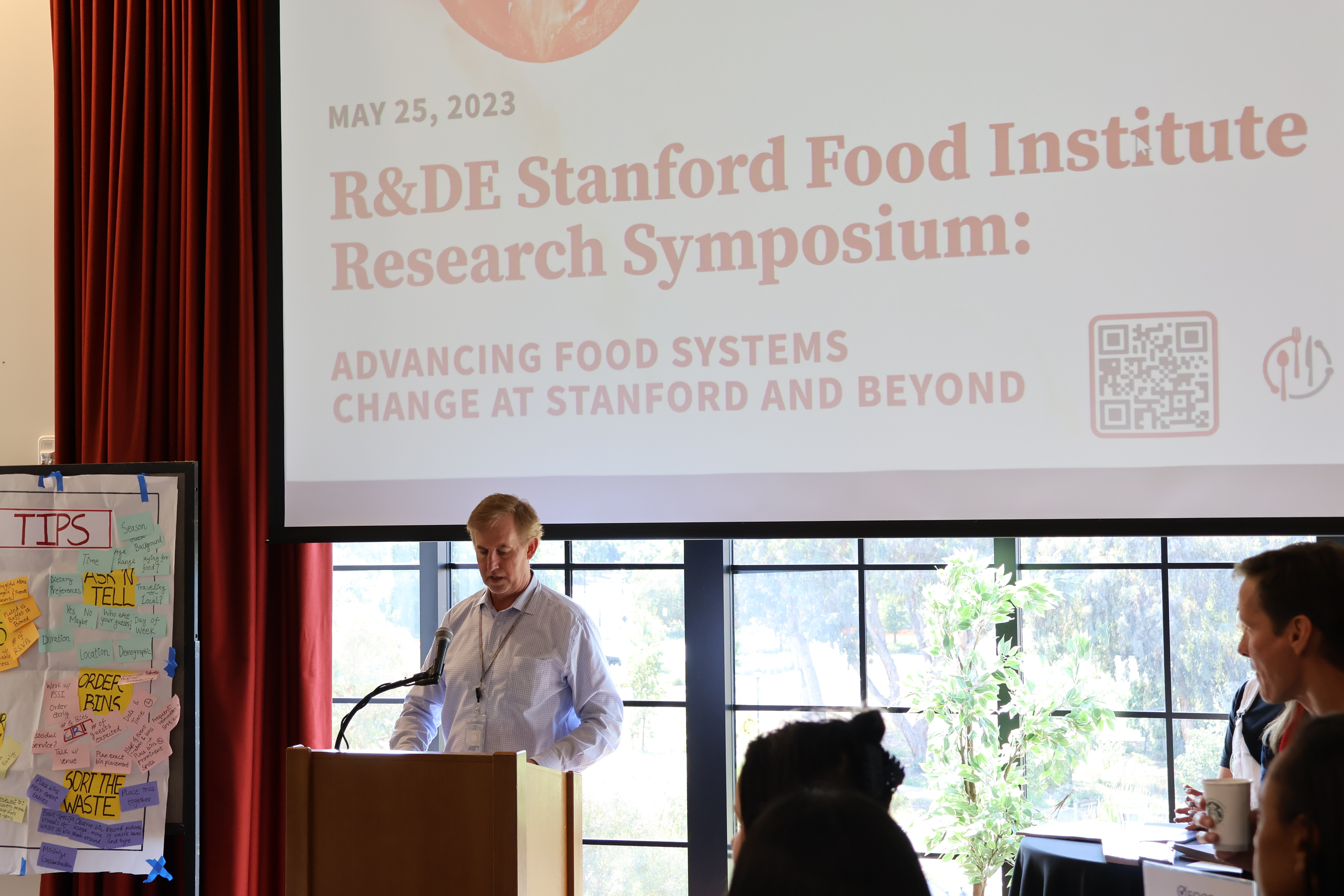Stanford researchers showcased research advancing food systems change on Thursday at the inaugural Stanford Food Institute Research Symposium hosted by Residential and Dining Enterprises (R&DE). The mission of the event was a collaboration between researchers, some of whom presented their work in areas such as extracting fertilizer from wastewater and improving soil quality with compost.
The symposium was the brainchild of Anna Gomes, a third-year Ph.D. student in Earth systems science. Gomes first reached out to Director of the Stanford Food Institute Sophie Egan a year ago to create an event that can foster a community of food-related researchers.
“After this symposium, the presenters will have met each other and learned about each other’s work and impacts,” Gomes said. “We can build this community and have future events where we can come back together and support each other.”
Following a networking event for researchers, Assistant Vice Provost of Stanford Dining, Housing & Auxiliaries Eric Montell opened the event, expressing gratitude for the planning committee. Referring to Dr. Shirley Everett, the Senior Associate Vice Provost for R&DE who did not attend the event, Montell expressed R&DE’s “mission to advance research, education, policy, business, and practice to promote a holistic approach to improving what people eat, how they access food and the role that food plays in our lives.”
“My sincere thanks to Dr. Everett for her compelling vision and continued strategic leadership for this expansive research program,” Montell said. “Our goal is always to create a brighter food future that includes faculty, staff and most importantly students in the process, and one that supports a diverse and inclusive community.”
Egan took the stage next expressing her excitement about the event. “It’s the first time that staff, faculty, students and alumni are coming together from all disciplines across campus to share their research, exchange ideas and foster collaborations to advance food systems change at Stanford and beyond,” Egan said.
Gomes, who led the creation of the Symposium, presented her research at the event, which examines how types of integrated nutrient management, such as combining compost with urine-recovered ammonium fertilizer, affect soil and plant health.
Her project demonstrated the importance of rich organic matter in soil by submerging a soil sample in a jar of water. This sample was rich in organic matter which secretes glues, keeping the soil together even in this rain-like condition. In contrast, Gomes explained how soil without much organic matter would come apart in torrential rains. She used this demonstration to emphasize the importance of soil health, mentioning how nitrogen and carbon content is necessary not only for plants, but also for the soil.
In addition, Gomes’s research compares the nitrogen and carbon content of compost samples from rural and urban areas to improve soil health. While showing attendees the devices she uses to measure different soil gases, Gomes pointed to the booth next to her, which highlighted the work of second-year earth systems science Ph.D. student Jack Lamb, whose research concerns rice irrigation strategies in California, to show how collaborations between different food and agriculture researchers helps progress research in the field.
“We have a chamber that measures carbon dioxide, but we’re also interested in nitrous oxide, the other big greenhouse gas. [Lamb is] building low-cost chambers that measure different soil gases,” Gomes said.
Gomes also introduced another chance research collaboration with Dean Miller, a third-year Ph.D. student in chemical engineering. Miller’s research, which he presented at the symposium, is focused on ways to extract fertilizer from wastewater.
“Effectively what we’re trying to do is take agricultural wastewaters and municipal wastewaters, and turn those two sources into treated water and purified nitrogen fertilizer,” Miller said.
Miller explained that agricultural and municipal wastewaters have two different forms of nitrogen as nitrate and urine. Their research group designed a reactor that can separately extract both types of nitrogen to form one final pure product.
“We’re finding that it’s actually really energy efficient to produce our fertilizers this way,” Miller said. “Every time you urinate, you’re producing between four and five grams of nitrogen. You can put that in your hand and that’s a lot of nitrogen that we’re getting.”
Gomes highlighted that the Symposium was meant to foster collaborations and conversations such as those between Miller and her.
“We were thinking ‘how can we [initiate conversations] more and on a bigger scale?’” Gomes said. “He’s in a completely different building. If I’m in a basement sieving soil, I’m not interacting with all [the other researchers in similar fields]. But it’s really cool to learn [about their projects].”
